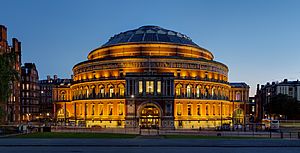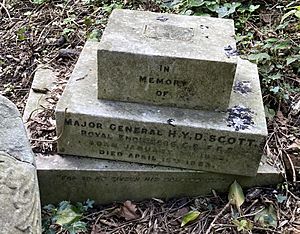Henry Young Darracott Scott facts for kids
Henry Young Darracott Scott was a British Major-General in the Corps of Royal Engineers. He is most famous for helping to build the Royal Albert Hall in London. He was born on January 2, 1822, and passed away on April 16, 1883.
Contents
Early Life and Education
Henry Scott was born in Plymouth, Devon, on January 2, 1822. He was the fourth son of Edward Scott. Henry studied at home before attending the Royal Military Academy, Woolwich. This academy trained future officers for the British Army.
Military Career and Innovations
Henry Scott joined the Royal Engineers as a second lieutenant in December 1840. After training at Chatham, he worked in Woolwich and Plymouth. He became a first lieutenant in 1843. In January 1844, he moved to Gibraltar. There, he helped manage his army unit.
In 1848, Scott returned to England. He became an assistant teacher at the Royal Military Academy in Woolwich. He taught about building defenses in the field. He was promoted to second captain in 1851. That same year, he got married. He also became the main teacher for field works at the academy.
New Discoveries and Teaching
In 1855, Scott became a first captain. He was also made a surveying teacher at Chatham. He worked closely with Colonel Henry Drury Harness. They helped to reorganize the army school there.
At Chatham, Scott ran the chemical lab. His experiments led to a special type of cement. This cement is called selenitic lime and is named after him. He also improved a system for drawing maps. This system used lines and shading to show ground features. The army adopted his method for military sketching.
While living in Brompton, Kent, there was a water shortage. Scott helped to set up a water system in the Luton valley. In 1863, he was promoted twice. First, he became a brevet major. Then, he became a regimental lieutenant-colonel.
Building the Royal Albert Hall
In 1865, Scott started working for the Great Exhibition of 1851 commission. This group managed the exhibition buildings in South Kensington. He quickly earned their trust. When Sir Henry Cole retired, Scott became the secretary for the commission.
Scott is best known for building the Royal Albert Hall in Kensington. He was put in charge of its design and construction in 1866. The roof design was very unusual. Many people thought it would not work. But Scott was confident. In 1870, it was time to remove the supports for the roof. Scott made everyone leave the building. He then knocked away the very last support himself.
Solving the Echo Problem
The hall had a problem with echoes, especially with wind instruments. To fix this, a large fabric screen was added below the main roof. This screen was called a "velarium." It helped to improve the sound quality. For his work, Scott was honored in 1871. He was made a Companion of the Bath.
In 1871, Scott became a brevet colonel. He then retired from the army as an honorary major-general. But he kept his job at South Kensington. He became a member of the Institution of Civil Engineers in 1874. In 1875, he was elected a Fellow of the Royal Society. He also joined a Russian scientific society. The Russian tsar gave him a special snuff-box with diamonds.
Scott also worked as an examiner for military mapping. He received medals for his work at several international exhibitions. These included the Great Exhibition of London in 1862 and the Paris Universal Exhibition of 1867.
In 1880, he won a silver medal for his ideas on London's sewage system. He also received an award for a paper on making and testing cement. Scott had plans to finish the South Kensington Museum. But in 1882, his job was ended to save money. This sudden change affected his health. He designed buildings for the Fisheries Exhibition. However, he was too ill to attend its opening. He passed away on April 16, 1883, at his home in Sydenham, London. He was buried at Highgate Cemetery.
Published Works
Scott spent his life serving the public. He did not gain personal wealth from his inventions. He wrote articles for the 'Transactions of the Royal Institute of British Architects.' He also contributed to the 'Professional Papers of the Corps of Royal Engineers.' These papers mainly discussed his new cement and the building of the Albert Hall.
Founding The Wine Society
Scott is also known for starting the International Exhibition Co-operative Wine Society Limited. This group is now simply called The Wine Society. It began in 1874. It first sold extra wine from the Great Exhibition. Then, Scott suggested creating a "co-operative company." This company would buy good quality wines regularly for its members. He served as The Wine Society's first Treasurer until his death in 1883.
Family Life
On June 19, 1851, Scott married Ellen Selina Bowes in Woolwich. She was the youngest daughter of Major-General Bowes. Henry and Ellen had fifteen children. Ellen survived him. Henry Scott was also the first cousin of John Edward Scott. John Edward Scott was a brewer and the father of the famous Antarctic explorer Robert Falcon Scott.



